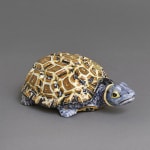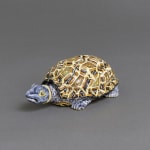

A Very Rare Schrezheim Faience Box and Cover in the Form of a Tortoise, Circa 1765-70
A Very Rare Schrezheim Faience Box and Cover in the Form of a Tortoise, naturalistically modelled and painted in ochre, manganese, and black. The removable shell is painted in speckled tortoiseshell pattern, while the body features scaled feet and tail. The tortoise pokes its head out with a grimace, eyes wide open and outlined in yellow.
Further Details
Box and Covers modelled as turtles were used as sweetmeat and butter dishes and were also produced by manufactories such as Fulda and Hochst.
Provenance
Erich Tgarht CollectionLiterature
Similar tortoise boxes and covers are illustrated by H. Erdner and G. Nagel, Die Fayencefabrik zu Schrezheim, nos.307 and 307a.
See a similar example in the Boston Museum of Fine Arts (2006.902a-b) published in Hugo Morley-Fletcher, Early European Porcelain & Faience: As Collected by Kiyi and Edward Pflueger (1993), 154.
For a discussion of the model see Thomas Rudi, Augenlust und Gaumenfreude: Fayence-Geschirre des 18. Jahrhunderts im Museum für Kunst und Gewerbe Hamburg (1998) where Rudi references a similar example in the Museum für Kunst und Gewerbe, Hamburg and examples in the collections of the Württembergisches Landesmuseum, Stuttgart, the Museum für Kunsthandwerk, Frankfurt, the Reiss-Museum, Mannheim, the Hetjens-Museum, Düsseldorf, and the Bielefeld City Collection.
See another example in the Metropolitan Museum of Art, New York (1974.356.250a, b)
For similar examples in Hochst, see Horst Reber, Die Kurmainzische Porzellan-Manufaktur Hochst, Vol. II (1986), 70.
Join our mailing list
* denotes required fields
We will process the personal data you have supplied in accordance with our privacy policy (available on request). You can unsubscribe or change your preferences at any time by clicking the link in our emails.

